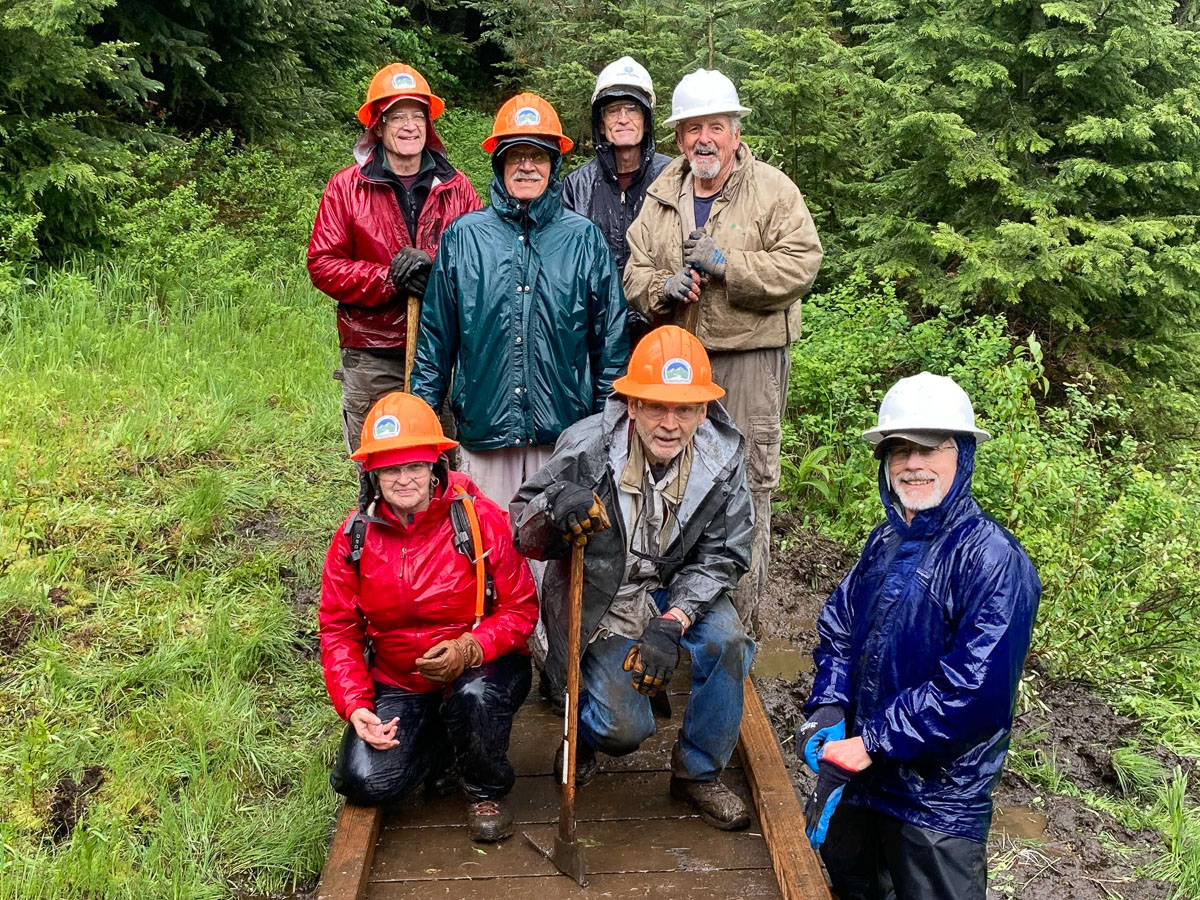
Trisha (red coat in the front row) on the 2024 Boulder Meadows Project
We’re thrilled to shine the spotlight on Trisha, one of ITA’s incredible volunteers whose passion for the outdoors and dedication to giving back has made a real impact on Idaho’s trails! Since discovering ITA through the hiking community, she’s jumped into trail work with both boots and heart—completing seven projects (and counting!) and even helping build a puncheon through mud, sleet, and teamwork. Trisha’s enthusiasm for connecting with others, learning new skills, and preserving Idaho’s wild places is exactly the kind of spirit that keeps our trail community strong. Thank you, Trisha, for all you do to protect and improve the trails we all love!
What is your background in? What are some of the things you enjoy doing for fun?
I am a retired municipal employee that has worked in Human Resources and Information Technology. I have lived in 5 different states and Idaho is one of the most beautiful. Being outdoors is my happy place. I enjoy hiking, kayaking, rock climbing, biking, camping, backpacking, geocaching and various other outdoor activities. My spouse and I met over a love of hiking, rollerblading and biking. We became docents at a local Nature Refuge. We started traveling, backpacking and exploring together. In addition to outdoor pursuits, I enjoy photography, gardening, teaching aerobics, reading (historical mysteries are my favorite) and doing various crafts such as cross stitch, crochet, sewing, and kimekomi.
While living in Texas, I got involved with the Becoming an Outdoor Woman (BOW) program and then TOWN (Texas Outdoor Women’s Network) where I became an event leader. I led hikes, camping events, and beginning backpack trips. In the last two years, I have gotten involved with a women’s hiking group that has chapters all over the world called Hiker Babes. I am an ambassador for the Spokane/North Idaho group. I lead hikes for the group and over the summer we hold a Couch to Summit Program (C2SP) that helps female hikers build distance and elevation over several months culminating in a hike to a local challenging peak. Our local group recently reached a new milestone having over 4,000 members now.
How and why did you first get involved with ITA? What are the different ways you’ve volunteered for ITA over the years?
I learned about ITA from Michelle Cornelsen of North Idaho Backpacking Babes who shared her story about a trip on Hell’s Canyon. I was looking for more ways to get involved in hiking in this area and wanted to find others who hiked and backpacked. My first trip was a women’s-only group trip that was a weekend car camping event. We obscured a trail which was new to me. Then we did some brush work and tree removal on a different section of trail. I learned a lot and met some great women. That got me to sign up for more trips and become a member. I recently just completed my 7th trail work project. Each one has been different and enjoyable. I have done tread work, worked on water bars, sawed fallen trees, obscured trail, removed brush, dug out roots and rocks and even helped build a puncheon. It is a great way to see trails you might not have been on before.
What do you like about volunteering with ITA?
I get to combine something I love doing – hiking and getting out in nature – with giving back to the trails and those who hike them. There are always great people to meet on these trips. It is fun to learn about their background and experiences that have brought them to volunteering with ITA. I also enjoy the teamwork. Sometimes you can work alone on small sections or do some independent work but a lot of the time you work together to get big things done.
Most memorable backcountry or ITA experience?
The 3rd or 4th project I did was building a puncheon (and yes, I had to look up what that was before I signed up)! If you don’t know, it is a low bridge or boardwalk usually over a marshy area or seep. It turned out that I was the only woman on a crew with 7 men, plus a forest service guy. The day started out rainy, foggy and cold. The first part of our job was carrying all the wood out to the site where we would build the puncheon. It was about a mile to the site. Some of the guys could strap these large, heavy boards to an old frame pack and carry them. I didn’t think I could do that and still carry my daypack. So a few of us tried tying some straps to the wood and dragging them. This worked for a while but every root or rock caught the boards and put an abrupt halt on forward progress until you lifted the board some. 2 of us decided to work together to suspend the boards with our straps with one in front and one in back. This worked! Next we had to dig and level spots for the large footer boards on either side. This involved standing in the muddy area we were trying to span. We were all wet, muddy and a little chilly. We then set the rails on the footers. A hand drill was used to put in rebar to keep these pieces in place. Then we started laying the planks and aligning them to a string line. Next, we started driving long nails into the planks. This turned out to be my strength. Everyone took turns but in the end, I got to do a lot of hammering. We then added low side rails on the edge of the planks. Did you know that those planks are spaced fairly close together so the puncheon can be crossed by stock animals? We had a lot of tools to return to the trail and the sleet started to fall as we made trips back to the vehicles. I was glad we had completed our major task by this point. We built a good-looking puncheon that will keep hikers out of the mud and protect this area from erosion and damage by lots of feet or hooves. I will probably not be signing up to haul any more large pieces of lumber down the trail for a while.
Why are trails worth protecting?
So many people use trails for recreation, sport, foraging etc. They are the roadways into special places. In a world that is bustling and busy, trails give us a place to escape and be in contact with nature. I think the size and interest in our local hiking groups show the need people have to be on the trails. We are lucky to live somewhere where there are lots of available trails. It is a big job to maintain them ALL.





